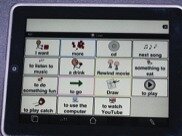Technology Supported
Autism Interventions in Daily Living


New IPad, IPod and similar devices have increasingly been used to support behavioral interventions for individuals with autism. Two such articles are described below. It is important that parents and practitioners are aware these devices will rarely be helpful unless coupled with behavioral training programs. Occasionally staff members or parents erroneously conclude they can simply hand a PDA or IPad to a person with autism and tell them to touch a square on the screen, and the device will take over. That almost never happens. But combined with well crafted behavioral intervention procedures, they can be very helpful.
Tony Gentry, PhD, of Virginia Commonwealth University in Richmond, VA. Recently published the results of a promising vocational support study for adults with autism. Adults with ASD often have valuable assets and strengths that are sought after in the workplace, such as logical and mathematical ability, exceptional computer skills, or strong visual memory The cases involve participants in a 4-year randomized trial examining the use of iPod touch® PDAs as job coaching aids in the workplace. Each individual was given a vocational placement and paired with a job coach. A therapist programmed an iPod touch® with an individualized suite of applications to provide support that included task reminders and lists, video prompts, tools for self-managing behavior, and other supports. The occupational therapist trained the participant and the job coach in using the device as a vocational aid. The occupational therapist set reminder alarms on the iPod touch® to cue Jeffrey to move from task to task during his shift. Using the Notes application, step-by-step checklists were created for each of Jeffrey’s tasks so he would be sure to complete them properly. Within a week, he was successfully responding to the reminder cues and checking his task notes. A year later, Jeffrey continues to use his iPod touch® on the job, and is recognized as a reliable employee.
Tony Gentry, Stephanie Lau, Alissa Molinelli, Amy Fallen, and Richard Kriner. Journal of Vocational Rehabilitation, 37: 2 (September 2012). DOI: 10.3233/JVR-2012-0601.
CONTINUE HERE
The strategies in the Gentry study are similar to those used by Linda LeBlanc, PhD. shown below, who has reported on technological advances have been successfully incorporated into behavioral autism spectrum disorders for over two decades in the form of video modeling, automated or remote-activated prompting systems, and personal digital assistants (PDAs). New technologies such as the Bluetooth wireless protocol and cost-efficient virtual reality platforms offer great options for teaching community skills that can be cumbersome or unsafe with traditional lower-tech methods. These interventions can be most powerful when basic behavioral principles are incorporated into their design and implementation rather than simply substituting technology for human efforts. This presentation will describe several important unanswered research questions about the efficacy, cost-effectiveness, and optimal parameters for implementing technology-based interventions and the evaluation strategies best suited for answering those questions. In addition, this presentation will present several questions that consumers should use to guide decision-making about the adoption of any new technology-based behavioral intervention.
protocol and cost-efficient virtual reality platforms offer great options for teaching community skills that can be cumbersome or unsafe with traditional lower-tech methods. These interventions can be most powerful when basic behavioral principles are incorporated into their design and implementation rather than simply substituting technology for human efforts. This presentation will describe several important unanswered research questions about the efficacy, cost-effectiveness, and optimal parameters for implementing technology-based interventions and the evaluation strategies best suited for answering those questions. In addition, this presentation will present several questions that consumers should use to guide decision-making about the adoption of any new technology-based behavioral intervention.
LeBlanc, L. A. (January, 2011). Designing and evaluating technology-based behavioral interventions for individuals with autism spectrum disorders. Presented at the ABAI 2011 Autism Conference, Washington, DC.
Tony Gentry, PhD, of Virginia Commonwealth University in Richmond, VA. Recently published the results of a promising vocational support study for adults with autism. Adults with ASD often have valuable assets and strengths that are sought after in the workplace, such as logical and mathematical ability, exceptional computer skills, or strong visual memory The cases involve participants in a 4-year randomized trial examining the use of iPod touch® PDAs as job coaching aids in the workplace. Each individual was given a vocational placement and paired with a job coach. A therapist programmed an iPod touch® with an individualized suite of applications to provide support that included task reminders and lists, video prompts, tools for self-managing behavior, and other supports. The occupational therapist trained the participant and the job coach in using the device as a vocational aid. The occupational therapist set reminder alarms on the iPod touch® to cue Jeffrey to move from task to task during his shift. Using the Notes application, step-by-step checklists were created for each of Jeffrey’s tasks so he would be sure to complete them properly. Within a week, he was successfully responding to the reminder cues and checking his task notes. A year later, Jeffrey continues to use his iPod touch® on the job, and is recognized as a reliable employee.
Tony Gentry, Stephanie Lau, Alissa Molinelli, Amy Fallen, and Richard Kriner. Journal of Vocational Rehabilitation, 37: 2 (September 2012). DOI: 10.3233/JVR-2012-0601.
CONTINUE HERE
The strategies in the Gentry study are similar to those used by Linda LeBlanc, PhD. shown below, who has reported on technological advances have been successfully incorporated into behavioral autism spectrum disorders for over two decades in the form of video modeling, automated or remote-activated prompting systems, and personal digital assistants (PDAs). New technologies such as the Bluetooth wireless
 protocol and cost-efficient virtual reality platforms offer great options for teaching community skills that can be cumbersome or unsafe with traditional lower-tech methods. These interventions can be most powerful when basic behavioral principles are incorporated into their design and implementation rather than simply substituting technology for human efforts. This presentation will describe several important unanswered research questions about the efficacy, cost-effectiveness, and optimal parameters for implementing technology-based interventions and the evaluation strategies best suited for answering those questions. In addition, this presentation will present several questions that consumers should use to guide decision-making about the adoption of any new technology-based behavioral intervention.
protocol and cost-efficient virtual reality platforms offer great options for teaching community skills that can be cumbersome or unsafe with traditional lower-tech methods. These interventions can be most powerful when basic behavioral principles are incorporated into their design and implementation rather than simply substituting technology for human efforts. This presentation will describe several important unanswered research questions about the efficacy, cost-effectiveness, and optimal parameters for implementing technology-based interventions and the evaluation strategies best suited for answering those questions. In addition, this presentation will present several questions that consumers should use to guide decision-making about the adoption of any new technology-based behavioral intervention.LeBlanc, L. A. (January, 2011). Designing and evaluating technology-based behavioral interventions for individuals with autism spectrum disorders. Presented at the ABAI 2011 Autism Conference, Washington, DC.